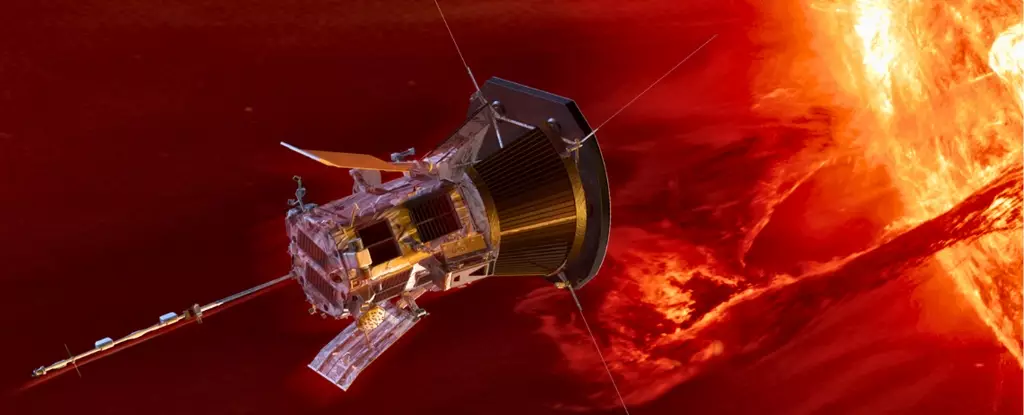In August 2018, humanity embarked on a groundbreaking journey to unveil the secrets of our closest star, the Sun, with the launch of NASA’s Parker Solar Probe (PSP). This mission marked not just a technical achievement, but a leap into a new paradigm of solar research. Through meticulous planning and innovative design, the probe was engineered to venture closer to the Sun than any spacecraft before, making it a pivotal tool in enhancing our understanding of solar phenomena. The probe’s destination? The outer corona of the Sun, a region that has mystified scientists for decades.
The Parker Solar Probe utilized Venus for gravity-assist maneuvers to incrementally reduce its distance from the Sun. On October 29, 2018, it officially eclipsed Helios 2’s distance record, establishing itself as the closest human-made object to the Sun. The probe’s journey employed an elliptical orbit that allowed for unprecedented high-speed encounters with the Sun’s atmosphere.
On December 24, 2024, NASA announced a monumental achievement: the Parker Solar Probe made its closest approach to the Sun, coming within just 6 million kilometers of its seething surface. This distance, approximately 0.04 Astronomical Units (AU), is significantly closer than previous missions, and it enabled the probe to collect a wealth of scientific data. The PSP moved through the solar atmosphere at a staggering velocity of roughly 692,000 kilometers per hour (430,000 miles per hour), positioning it as the fastest human-made object in history. This velocity is equivalent to a mere 0.064% of the speed of light, underlining both the peril and potential inherent in such a mission.
Following its close approaches, the probe transmitted a beacon tone confirming its successful entry and exit from the atmosphere—a signal of triumph that was received two days later on December 26. These flybys are not mere accomplishments; they serve as critical windows into the dynamics of solar wind and enable scientists to gather invaluable insights regarding solar interactions with planetary bodies.
Underpinning the Parker Solar Probe’s capabilities is a suite of advanced technologies designed to endure the Sun’s intense environment. A carbon foam shield protects essential components and instruments from the extreme heat of the corona, with standing temperatures that can soar between 980 and 1,425 degrees Celsius (1,800 to 2,600 degrees Fahrenheit). Despite these ferocious conditions, the probe’s design ensures that instruments remain shielded and functional at room temperature, enabling them to operate effectively.
In an illuminating statement, Nicky Fox, the Associate Administrator for NASA’s Science Mission Directorate, articulated the broader significance of this exploratory endeavor: “Flying this close to the Sun is a historic moment in humanity’s first mission to a star.” This underscores the dual importance of understanding both the Sun’s influence on our technological world and its broader role in the cosmic landscape.
The Parker Solar Probe represents a culmination of decades of scientific ambition, first proposed in 1958 by the National Academy of Sciences. Although initial plans met several technological hurdles, advances over the intervening years paved the way for this historic mission. Throughout its journey, the probe has yielded unexpected discoveries, such as the identification of a uniquely structured outer boundary of the corona and insights into the mysterious “switchbacks” in the solar wind—zigzagging features that were once thought to be largely impractical.
Aside from its direct observations of the Sun, the Parker Solar Probe has provided critical data for understanding how solar activity affects space weather—an increasingly relevant subject as our technological society relies heavily on satellite technology and other systems sensitive to solar influences. The probe’s findings extend beyond solar insights, as it has also captured significant data regarding Venus, including radio emissions and the first complete images of its orbital dust ring.
The Parker Solar Probe’s mission is far from over. Future passes through the Sun’s corona are scheduled, with key dates set for March 22 and June 19, 2025. As scientists anticipate the influx of data from each solar encounter, there is a collective excitement about the knowledge that will help decode solar mysteries and potentially indicate the conditions necessary for habitability beyond Earth.
As Adam Szabo, the mission scientist, noted, “This close approach will give us more data to understand how it’s accelerated closer in.” With every terrestrial advancement and cosmic discovery, the Parker Solar Probe not only sets new benchmarks in solar research but also paves the way for future explorations of our solar system and beyond. It stands as a testament to human curiousity and resilience, propelling science into a new golden age of solar exploration.

